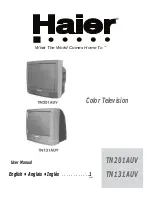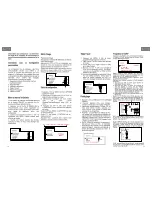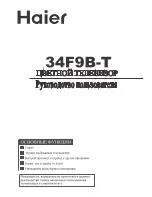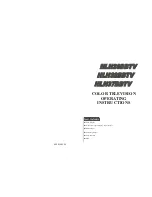
Working principle analysis of the unit
1. PAL/SECAM signal flow:
Antenna reception PAL/SECAM signal will be send to tuner TDA1616, which contains frequency
turning, HF and IF amplifier circuit and is controlled by master control IC MSD119 (comprises CPU)
through I2C bus. The analog IF signal via intermediate frequency amplifying, video SAW filter
K3953 and audio SAW filter K9656 to input to analog demodulate IC (IF) R2A10406NP, after
demodulating and output standard video signal TV-CVBS and sound IF signal (SIF).
TV-CVBS will send to the master control IC MSD119 to video decode, deinterlace and scale, then
output LVDS level drive for LCD panel.
The sound IF (SIF) will be fed into MSD119, after demodulating, pre-amplifying, bass adjusting and
volume control, the sound signal will separate into L/R channels and input to operational amplifier
AZ4558 amplifying, then output two ways. One way will be sent to earphone, another will be sent to
class AB sound amplifier TDA7266SA amplifying then sent to speaker.
2. DVB-T signal flow:
Antenna reception DVB-T signal will be sent to tuner TDA1616, after frequency tuning, HF
amplification, IF amplification and SAW FILTER, output IF signal to demodulation chip CE6353, via
QAM demodulation, fed to MSD119 for information source decoding in the format of standard serial
TS stream.
HD video signal via decoding to A/D conversion and OSD superposition, at last output LVDS drive
level for panel display.
HD audio signal via decoder built-in MSD119, resumed to multi- channel sound of Dolby AC-3. The
audio signal will be sent to back end to perform bass adjustment and volume control,
then it will
separate into L/R channels and input to operational amplifier AZ4558 amplifying, another way will
be sent to class AB sound amplifier TDA7266SA amplifying then sent to speaker.
3. AV signal flow
AV signal will be fed to MSD119 to perform video decode, deinterlace and scale, then output LVDS
drive level for panel display.
Audio signal from AV via matched resistance, is directly sent to MSD119 to bass adjust and volume
control, the sound signal will separate into L/R channels and input to operational amplifier AZ4558
amplifying, then output two ways. One way will be sent to earphone, another will be sent to class AB
sound amplifier TDA7266SA amplifying then sent to speaker.
4. PC/YPrPb signal flow
PC and YPbPr signal will be sent to MSD119 A/D conversion, output R/G/B of 24 bit to back end
module to digital decode, image scale and OSD superposition, then send to LVDS level drive for
panel display. Sound signal of PC/YPrPb via matched resistance and a-c couple to MSD119 to bass
adjust and volume control, the sound signal will separate into L/R channels and input to operational
amplifier AZ4558 amplifying, another will be sent to class AB sound amplifier TDA7266SA
amplifying then sent to speaker.
5. HDMI signal flow
HDMI video signal is directly fed to the master control IC MSD119 to digital decode, image scale
12
Summary of Contents for LCD-22XR9DA
Page 12: ...Fig4 4 Click Auto select All chip and programme and click Run to begin writing Fig5 10 ...
Page 16: ...IC block diagram 1 MSD119CL LF 14 ...
Page 17: ...15 ...
Page 18: ...16 ...
Page 19: ...17 ...
Page 20: ...18 ...
Page 21: ...19 ...
Page 22: ...20 ...
Page 26: ...24 ...
Page 33: ...main chip memory 1 11 ...
Page 34: ...video audio interface 2 11 ...
Page 35: ...RF receiving 3 11 ...
Page 36: ...non video audio interface 4 11 IR board key board key board IR board key board IR board ...
Page 37: ...power board 5 11 ...
Page 38: ...backlight board 6 11 backlight board backlight board ...
Page 39: ...power with dual lamp tube for backlight board 7 11 ...
Page 40: ...power with four lamp tube for backlight board 8 11 ...
Page 41: ...T CON board 9 11 ...
Page 42: ...power 10 11 ...
Page 43: ...backlight 11 11 ...
Page 45: ...APPENDIX B Exploded view LCD 22XR9DA ...
Page 51: ...June 2009 ...















































